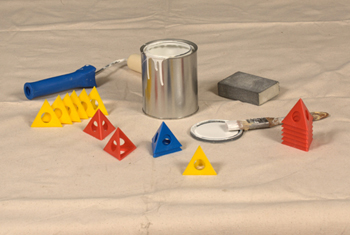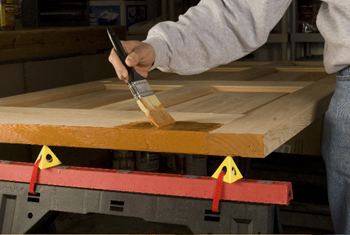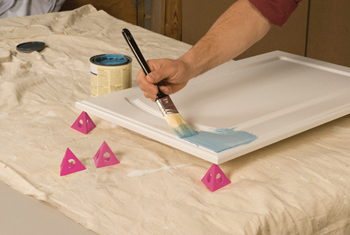
Sometimes great inventions emerge out of little frustrations. That was the case with Michael Bucci, the inventor of a simple, versatile, stackable, colorful and astonishingly helpful little tool called the Painter’s Pyramid. Don’t let its modest looks fool you. Though it is merely a small, hollow plastic shell with three holes, it has helped countless finishers save time and annoyance, and freed its inventor from a corporate cubicle.
“The Painter’s Pyramid allows you to paint all sides of an object in one session,” Michael explained. “Coat one side of your piece, flip it over, and rest it on the points of the pyramid. The pyramid base gives it stability, and the fact that it is made of a specially formulated high density plastic means wood finishes won’t stick to it. As a result, the pyramids are easy to clean if you do get drips or overspray on them, and they can’t stick to the underside of the wet piece. The plastic is strong and chemical resistant. The pyramids can hold an object up to 200 pounds and resist most finishing solvents without being harmed. The tip is slightly rounded so that unlike sharp pointed nails, it won’t damage the wood, even with softwood.
“Each side has a hole so you can tie them down with a strap through the holes, or mount a series of pyramids on a five-eighths-inch dowel. A strip of pyramids on a dowel are perfect for holding long moldings. Even if you are not painting the back side, propping the molding allows you to paint all the way to the edge without it ending up stuck onto your bench with paint.
“The base is open so that they can stack, not only for storage, but also as a means of creating a taller pyramid by stacking. That lets you get the piece higher, or even set it on an angle by using taller ones on one side. Taller pyramid stacks are handy even when you are not painting. In fact, they are ideal for gluing a case together. Stand the case on pyramids and you have clearance for the clamps even below the bottom board, and glues won’t stick to them either. We offer them in the primary colors and pink because people like choices, and some colors are easier to spot on the shop floor, should you drop one.”
How did this clever little product come about? “After getting a degree in manufacturing engineering,” Michael recounted, “I went to work for General Electric, then went back to business school, became a management consultant, and moved to the financial industry. During that time I went back and got another degree in information technology.
“One day I was finishing some unfinished bookshelves at home and was intending to put two coats of primer and two coats of paint. I quickly got tired of painting one side, going through the dubious joy of cleaning up, then waiting overnight before I could paint the other side.
“Of course, I knew about nail boards; a board with nails through it so that the wet, painted object sits on the nail points. However, I had twenty shelves to paint, and I did not want to waste twenty boards by driving nails into them and tying them up while the paint dried. Instead, I grabbed a piece of four by four and made a whole mess of wood pyramids on my miter saw. I knew I needed a small contact point and a stable base, and the pyramid was the ideal shape.
“I tried them out and they worked like a charm. They left a tiny but insignificant mark, one I could live with, and they saved me a whole lot of time. I liked it so much I decided to patent it. I thought it would be neat to have my own patent, but at the time had no immediate plans to exploit it.
“About six months later ,I was working in a financial services company when they decided to dissolve my department. On the one hand, I had this cool new product, and on the other hand I had no job. If they had not fired me, Painter’s Pyramid might still be an unused patent languishing in a drawer, but that was not the only coincidence that contributed to the pyramid coming to fruition.
“I went to a patent firm in town, but before I could get the papers filed, the attorney I spoke to left the firm. The other partner was vastly more expensive and I was not sure I wanted to spend that much for the patent. As luck would have it, that morning I got an email from a frat brother from college whom I had not spoken to in 15 years. We got together and I discovered he was now a patent attorney. He ended up doing the patent work.
“We launched the pyramid at the National Hardware show, which is one million square feet of boxes piled everywhere. I was climbing through trying to find where my booth was supposed to be when I stumbled across a company that sold paint products. A guy in the booth looked up and said ‘Mike?’ He was the quarterback from my old high school football team. His company became one of the first to carry the Painter’s Pyramid.
“These days you can buy them from woodworking specialty stores or direct from the website. Bought in packs of four, they cost about a dollar apiece, but they get much cheaper as you buy them in larger volumes. For example, if you by them by the gross, 144 at a time, the cost is cut in half.
“Don’t be surprised to see some new products coming out. One item on the drawing board is a turntable with built-in movable pyramids that’s ideal for spray finishing virtually any size or shape object up to 200 pounds.”
If this sounds like just the solution you’ve been waiting for, you are not alone. “We introduced Painter’s Pyramid only a year and a half ago,” Michael told me, “and already have sold over two and a half million. So to all the woodworkers out there, thank you for being so receptive to my invention. It’s allowed me to escape my corporate cubicle and spend my time with pyramids instead.”









